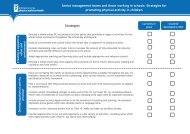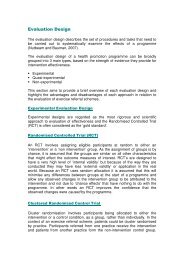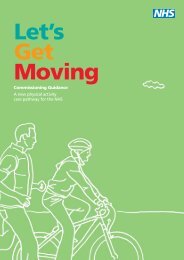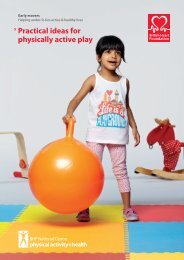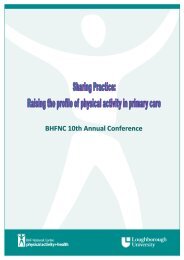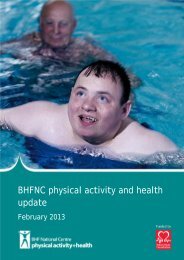12 <strong>Physical</strong> Activity Statistics, <strong>2012</strong>Regional, ethnic and socioeconomic differencesRegional variation in adult self-report physical <strong>activity</strong>levels is not marked, although there are differences.After accounting for differences in the age-structure ofthe population in each region of England, 44% of menin the South West reported meeting physical <strong>activity</strong>recommendations, compared to 33% of men in theNorth East. For women, the highest proportion wasreported in South Central at 34%, while the lowest was25% for women in the East of England (Table 1.6).The Health Survey for England 2008 shows a substantialdifference in physical <strong>activity</strong> levels in adults byequivalised household income quintile. There werehigher percentages of men and women meeting therecommended levels in the highest income quintilecompared to the lowest. Differences between highestand lowest quintiles was greater for men (42% comparedto 31%) than for women (34% compared to 26%) (Table1.7, Figure 1.7). Compared with the general population in2004, Indian, Pakistani, Bangladeshi and Chinese men andwomen living in England were less likely to meet physical<strong>activity</strong> recommendations. Of the men, Bangladeshiand Pakistani men had the lowest prevalence ofmeeting physical <strong>activity</strong> recommendations (26% and28%). This pattern was also true of women from thesegroups, at 11% and 14% respectively. Irish men andBlack Caribbean women had the highest prevalence ofmeeting the recommendations compared to any otherethnic groups living in England (Table 1.8, Figure 1.8).Comparing self-report and objective <strong>activity</strong> levelsWhile self-report is the most commonly used methodto measure physical <strong>activity</strong>, this has the potential toinaccurately measure physical <strong>activity</strong> prevalence 7 .Its advantages are that it is easy to collect data froma large number of people at low cost; however socialdesirability may lead to over-reporting of physical<strong>activity</strong>. Certain sections of the population such as theelderly and children may have difficultly accuratelyrecalling their activities, and it is also possible that therespondent may have a different understanding ofwhat ‘moderate intensity’ or ‘exercise’ actually means.In 2008, the Health Survey for England measuredphysical <strong>activity</strong> using self-report methods, as well asaccelerometers, which are an objective measure of aperson’s <strong>activity</strong>. Accelerometers measure frequency,intensity and duration of physical <strong>activity</strong>, but are notwaterproof and may not accurately record activities suchas cycling or rowing. People were asked to wear theaccelerometers while awake for seven consecutive days,but to take them off when swimming or showering. Dueto issues of consent, eligibility, compliance and faultswith the devices only 49% of men and 46% of womenfrom the 4,507 adults selected to wear accelerometersprovided sufficient data to be included in the analysesof daily average wear. Of the 1,707 children aged 4to 15 selected 43% of boys and 47% of girls providedsufficient data 8 . For children, whereas self-reporteddata covered sedentary behaviour in leisure timeexcluding time at school, those participants sampledto wear accelerometers were encouraged to wear themat all times including at school. This may account forsome differences between self-reported and objectivedata for these age groups. 8 When the prevalence ofmen and women meeting the recommended levels ofphysical <strong>activity</strong> are compared using self-report andaccelerometry data, large differences are apparent.Thirty nine percent of men and 29% of women inEngland reported meeting the recommendations,however, when measured using an accelerometer itwas found that only 6% of men and 4% of women metthese. Both self-report and objective measures foundthat the levels of physical <strong>activity</strong> declined with age inboth men and women (Table 1.9, Figures 1.9a and 1.9b).Accelerometry data by tertile of equivalised householdincome does not show a clear trend, as was seenwith the self-report data. For men, more people inthe highest tertile were meeting recommendations,however for women it was those who were inthe lowest tertile (Table 1.10, Figure 1.10).
<strong>British</strong> <strong>Heart</strong> <strong>Foundation</strong> and University of Oxford 13The Health Survey for England in 2008 alsogave a subsample of children aged 4 to 15 yearsaccelerometers to wear. In boys aged 4 to 10, 51%were meeting the recommended levels of <strong>activity</strong>for children, however for boys aged 11 to 15 this wasonly 7% whilst 75% were classified as having lowlevels of <strong>activity</strong>. The prevalence of physical <strong>activity</strong>in girls was even lower, with 34% of girls aged 4 to 10meeting the recommended levels, but no girls aged11 to 15 exercising to this level. Ninety six percent ofgirls in this age group were measured as having low<strong>activity</strong> levels (Table 1.11, Figures 1.11a and 1.11b).Cardiac rehabilitationIn 2009-10, 42% of patients who had a heart attack (MI),bypass surgery (CABG), or an angioplasty (PCI) tookpart in cardiac rehabilitation (CR) across England, Walesand Northern Ireland, with the aim of reducing cardiacmortality, promoting self-management and improvingquality of life 9 . In 2000 the National Service Framework(NSF) for Coronary <strong>Heart</strong> Disease recommended that at12 months at least 50% of individuals who had taken partin cardiac rehabilitation should be taking regular physical<strong>activity</strong> of at least 30 minutes duration on averagefor five times each week 10 . The 2011 National Audit ofCardiac Rehabilitation found that a greater proportionof patients reached these NSF recommended levelsafter they had undergone cardiac rehabilitation, with53% achieving these levels 12 weeks after rehabilitationand 49% 12 months after. Although a smaller numberof patients were sampled 12 months after rehabilitationthan 12 weeks (Table 1.12, Figures 1.12a and 1.12b).1. World Health Organization (2010). Global Recommendationson <strong>Physical</strong> Activity for Health. WHO: Geneva.2. Department of Health, <strong>Physical</strong> Activity, HealthImprovement and Protection (2011). Start active, stayactive: a report on physical <strong>activity</strong> from the fourhome countries. Chief Medical Officers: London.3. Scarborough P, Bhatnagar P, Wickramasinghe K, AllenderS, Foster C, Rayner M. (2011). The economic burden of illhealth due to diet, physical in<strong>activity</strong>, smoking, alcoholand obesity in the UK: an update to 2006–07 NHS costs.J Public Health. doi: 10.1093/pubmed/fdr0334. Department of Health (2004). At least five a week:evidence on the impact of physical <strong>activity</strong> and itsrelationship to health. Department of Health: London.5. Department of Health (2005) Choosing Activity: a physical<strong>activity</strong> action plan. Department of Health: London.6. Welsh Assembly Government (2011). Health Behaviour inSchool – aged Children: initial findings from the 2009/10survey in Wales. Social Research Division: Cardiff.7. Sallis F, SaelensB (2000). Assessment of <strong>Physical</strong> Activity bySelf-Report: Status, Limitations, and Future Directions. ResearchQuarterly for Exercise and Sport. American Alliance for Health,<strong>Physical</strong> Education, Recreation and Dance (AAHPERD).8. Department of Health (2010). Health Survey for England 2008:<strong>Physical</strong> <strong>activity</strong> and fitness. The Stationery Office: London.9. <strong>British</strong> <strong>Heart</strong> <strong>Foundation</strong> (2011). The National Auditof Cardiac Rehabilitation: Annual Statistical Report2011. <strong>British</strong> <strong>Heart</strong> <strong>Foundation</strong>: London.10. Department of Health (2000). National Service Frameworkfor Coronary <strong>Heart</strong> Disease: Modern Standards andService Models. The Stationery Office: London.
- Page 2: © British Heart Foundation, July 2
- Page 7: British Heart Foundation and Univer
- Page 10 and 11: 8 Physical Activity Statistics, 201
- Page 12 and 13: 10 Physical Activity Statistics, 20
- Page 16 and 17: 14 Physical Activity Statistics, 20
- Page 19: British Heart Foundation and Univer
- Page 24 and 25: 22 Physical Activity Statistics, 20
- Page 26 and 27: 24 Physical Activity Statistics, 20
- Page 28 and 29: 26 Physical Activity Statistics, 20
- Page 30 and 31: 28 Physical Activity Statistics, 20
- Page 32 and 33: 30 Physical Activity Statistics, 20
- Page 34 and 35: 32 Physical Activity Statistics, 20
- Page 36: 34 Physical Activity Statistics, 20
- Page 40 and 41: 38 Physical Activity Statistics, 20
- Page 42 and 43: 40 Physical Activity Statistics, 20
- Page 44 and 45: 42 Physical Activity Statistics, 20
- Page 46 and 47: 44 Physical Activity Statistics, 20
- Page 48 and 49: 46 Physical Activity Statistics, 20
- Page 50 and 51: 48 Physical Activity Statistics, 20
- Page 52 and 53: 50 Physical Activity Statistics, 20
- Page 54 and 55: 52 Physical Activity Statistics, 20
- Page 56 and 57: 54 Physical Activity Statistics, 20
- Page 58 and 59: 56 Physical Activity Statistics, 20
- Page 61 and 62: British Heart Foundation and Univer
- Page 63 and 64: British Heart Foundation and Univer
- Page 65:
British Heart Foundation and Univer
- Page 68 and 69:
66 Physical Activity Statistics, 20
- Page 70 and 71:
68 Physical Activity Statistics, 20
- Page 72 and 73:
70 Physical Activity Statistics, 20
- Page 74 and 75:
72 Physical Activity Statistics, 20
- Page 76 and 77:
74 Physical Activity Statistics, 20
- Page 78 and 79:
76 Physical Activity Statistics, 20
- Page 80 and 81:
78 Physical Activity Statistics, 20
- Page 82 and 83:
80 Physical Activity Statistics, 20
- Page 84 and 85:
82 Physical Activity Statistics, 20
- Page 86 and 87:
84 Physical Activity Statistics, 20
- Page 88 and 89:
86 Physical Activity Statistics, 20
- Page 90 and 91:
88 Physical Activity Statistics, 20
- Page 92 and 93:
90 Physical Activity Statistics, 20
- Page 94 and 95:
92 Physical Activity Statistics, 20
- Page 96 and 97:
94 Physical Activity Statistics, 20
- Page 98 and 99:
96 Physical Activity Statistics, 20
- Page 100 and 101:
98 Physical Activity Statistics, 20
- Page 102 and 103:
100 Physical Activity Statistics, 2
- Page 104 and 105:
102 Physical Activity Statistics, 2
- Page 106 and 107:
104 Physical Activity Statistics, 2
- Page 108 and 109:
106 Physical Activity Statistics, 2
- Page 110 and 111:
108 Physical Activity Statistics, 2
- Page 112 and 113:
110 Physical Activity Statistics, 2
- Page 114 and 115:
112 Physical Activity Statistics, 2
- Page 116 and 117:
114 Physical Activity Statistics, 2
- Page 118 and 119:
116 Physical Activity Statistics, 2
- Page 120 and 121:
118 Physical Activity Statistics, 2
- Page 122 and 123:
120 Physical Activity Statistics, 2
- Page 124 and 125:
122 Physical Activity Statistics, 2
- Page 126 and 127:
124 Physical Activity Statistics, 2
- Page 128 and 129:
126 Physical Activity Statistics, 2
- Page 130 and 131:
128 Physical Activity Statistics, 2



